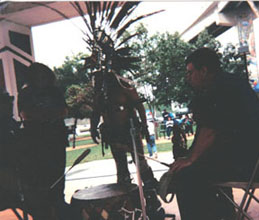By Roy Cook
The Annual Day of
the Dead - Día de los Muertos Saturday, October 29, 2005, from
12, noon to 5:00 p.m. takes place at Chicano Park. This is located under
the Coronado Bridge, one block east of Cesar Chavez Parkway and Logan
Avenue, in San Diego.
 Over
27 years ago Toltekas en Aztlan performed with poetry and traditional
dances at the first Día de los Muertos in Chicano Park, the public
was invited to participate in the ceremony. Once again, the Toltekas en
Aztlan: Rick Sainz, Julia, Ocelot and others are there. Also, invited
by the organizers and Ixleca, to open the ceremony are the Intertribal
singers of San Diego: Tim Redbird, Kiowa with Albert, Henry Mendibles,
Apache, Steve Rouillard, Dakota Sioux, Ben Nance and Roy Cook, Opata-Oodham.
Over
27 years ago Toltekas en Aztlan performed with poetry and traditional
dances at the first Día de los Muertos in Chicano Park, the public
was invited to participate in the ceremony. Once again, the Toltekas en
Aztlan: Rick Sainz, Julia, Ocelot and others are there. Also, invited
by the organizers and Ixleca, to open the ceremony are the Intertribal
singers of San Diego: Tim Redbird, Kiowa with Albert, Henry Mendibles,
Apache, Steve Rouillard, Dakota Sioux, Ben Nance and Roy Cook, Opata-Oodham.
Richard Parker Van Dyke, Omaha, danced in Traditional Northern regalia. He and his wife Joyce from the Santa Ysabel Band of the Kumeyaay along with their daughter Jeanette enjoyed the day. There are familiar faces from the local California Bands: Eddie La Chappa, Two brothers from La Jolla band of Luiseno, Anthony Pico’s’ son. Also attending are five Dine’ members of the All Nations Juniors and their Navajo families. All were participating to some degree and enjoying the warmth of the day
Día de los Muertos is misunderstood in many parts of the country and world. According to Day of the Dead lore, the spirits of loved ones are allowed to return to earth on El Día de los Muertos, enticed by the spicy scent of marigolds, incense, tamales and other pleasures they enjoyed on earth.
Día de los Muertos is a 4,000-year-old tradition that originated in Mexico with the Aztecs, who held elaborate ceremonies and a feast day for the dead.
The celebration was superimposed into the Roman Catholic traditions of All Saints' Day - Nov. 1 - remembering saints and children, followed by All Souls' Day - Nov. 2 - remembering adults who have died. Often, first time visitors to Día de los Muertos are caught off guard when they see the artistic skulls made from sugar and skeletal art of all kinds.
In Mexico, and now in the United States, people build altars at home in recognition of Día de los Muertos. The tradition is to welcome the souls of the deceased. It is said the souls can enjoy the essence of what is left on the altar.
The celebration is a lighthearted and whimsical way of viewing death.
Significantly, with this observance of Día de los Muertos, children are taught that death is a normal part of the cycle of life and not something so terrifying..
Día de los Muertos glossary:
Angelitos - Little angels, the souls of children who are remembered on Nov. 1, the feast of All Saints Day.
Calaca - The Grim Reaper, a dancing skeleton figure who represents death.
Calaveritas de azucar - Sugar skulls.
Cempazuchitl - A bright orange or yellow marigold, the traditional flower of the dead. Its pungent scent is believed to "attract the souls and draw them back."
Dulce de calabaza - Candied pumpkin.
Ofrenda - Offerings or gifts set out for the dead; also the actual altar.
Papel picado - Mexican folk art. Colorful, intricate paper cutouts used for decoration. Skeletons are usual for Días de los Muertos.